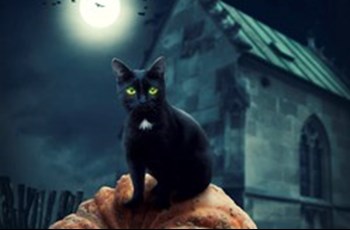
Do you enjoy feeling scared? Not in a life-threatening way. In a safe, controlled environment, scared in a "fun way," without any consequences?
The mechanisms of thrill-seeking evolved from the very same mechanisms that allowed us to survive as a species – the fight or flight response, wired into our biochemistry. This time of year we scare ourselves with the sole purpose of experiencing the blurry territory between the living and the dead. The strong emotional response associated with Halloween is one of the reasons why many people love it so.
There are many people who very much enjoy pushing that panic button and voraciously devour that adrenalin-laced adventure rush. Roller coasters, slasher movies, cliff jumping, and ghost stories by the bonfire – they all have something in common in that they exhilarate the human mind with terror. Scary situations are not for everyone, but some of us covet the experience. We discover awe when reality bends and laws of nature are violated.
Let’s walk through a haunted house.
You step in, enveloped by darkness. Moments before the chaos ensues, it’s just you and your hammering heartbeat. You anticipate something or someone to startle you. Immediately your body fine-tunes its senses to prepare for that fight or flight. The intensity of the moment, the razor-sharp focus, the fast breathing, the nervous perspiration – all make you feel alive, excited, anxious. Our brain is fast at processing the perceived threat, immediately alerting the rest of the body about the surrounding environment.
The heightened tone of neurochemicals renders you ready for what’s about to come. |
The first-wave neurochemical response, within a split second, activates the sympathetic nervous system, flooding the periphery with norepinephrine and epinephrine released from the adrenal glands and nerves. Very quickly, these catecholamine molecules utilize the vagus nerve as a communication platform, to signal the brain to make more norepinephrine, along with some serotonin, dopamine, neuropeptides and neurosteroids for good measure [1].
The monoamine chemical cocktail helps the body process stimulatory inputs and translate them into appropriate behaviors. Specifically, norepinephrine allows you to take in the bigger picture, to scan the environment for immediate threats (what are those slithering shadows on the walls?); dopamine, the major decision-maker, helps assess risk and devise strategies for how to deal with the situation (it’s not too late to walk out now…); and serotonin is there to reduce post-stress anxiety (phew!) [1] The heightened tone of neurochemicals renders you ready for what’s about to come.
And so it begins. The strobe light jarringly flashes bright white blasts to intermittently irradiate the room full of strange objects, spider webs, and skeletons. The scary clown stumbles nearby. The girl from “The Ring” climbs out of the black and white TV set with long heavy black matted hair concealing her face, the rumble of a chain saw cuts through the stagnant air somewhere close…
Everything feels so real, intrusive and acute. Your pulse quickens even more, making it seem your heart is about to jump out of your chest. Blood pressure rises, pupils dilate, face flushes. All the while the brain continues to encode emotionally relevant information by enhancing synaptic excitability. A few minutes into the ordeal, the initial neurotransmitter response begins to subside allowing for cortisol to step in and take over [2]. Not only does cortisol help form and sort the memories, it also helps reactivate old fearful memories as needed in the future to allow a faster response to a familiar threat [3].
Before you know it, it’s over. And now you’re done. You walk out. You feel an almost immediate sense of relief as your inhibitory neurotransmitters flood the neurons with chloride, gently braking the excitation speed train to a more manageable slow and steady hum.
Isn't the body amazing? The very same sophisticated system that was designed to protect us and prepare us for imminent threats can be exploited for the sheer fun of it.
Related Resources
- Blog: Epinephrine & Norepinephrine as Part of a Healthy Stress Response
- Blog: Stress, Hormones & Weight Gain
- Blog: How to Use the Cortisol Awakening Response (CAR) in Addressing Adrenal Function
References
[1] Joels M, Baram TZ: The neuro-symphony of stress. Nat Rev Neurosci 2009;10:459-466.
[2] Stockhorst U, Antov MI: Modulation of Fear Extinction by Stress, Stress Hormones and Estradiol: A Review. Front Behav Neurosci 2015;9:359.
[3] Drexler SM, Merz CJ, Hamacher-Dang TC, Tegenthoff M, Wolf OT: Effects of Cortisol on Reconsolidation of Reactivated Fear Memories. Neuropsychopharmacology 2015;40:3036-3043.
